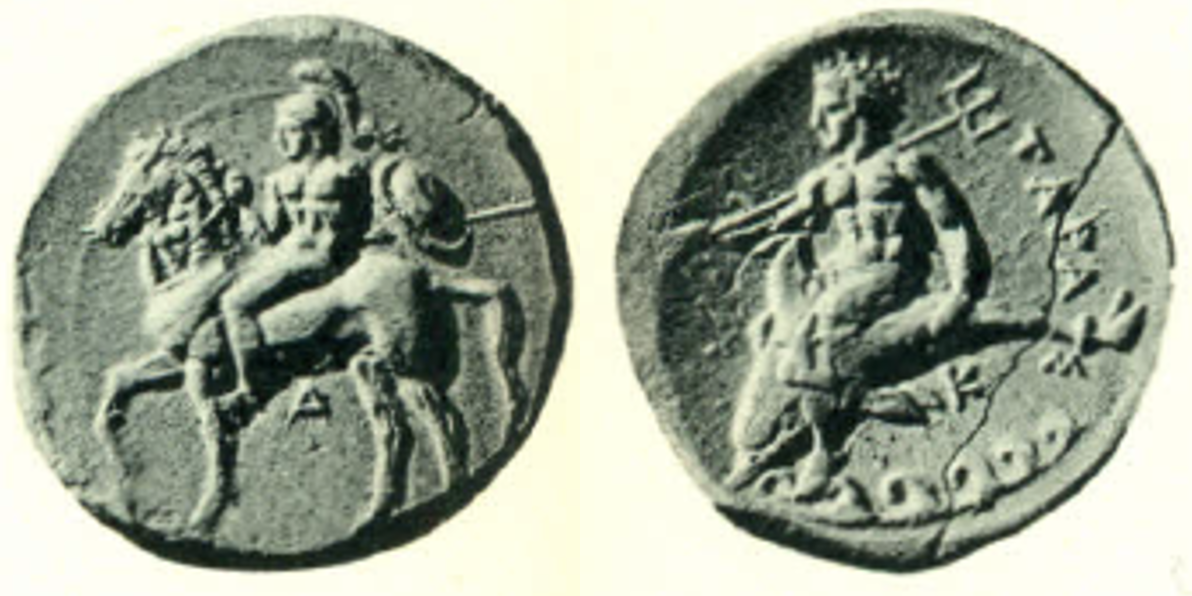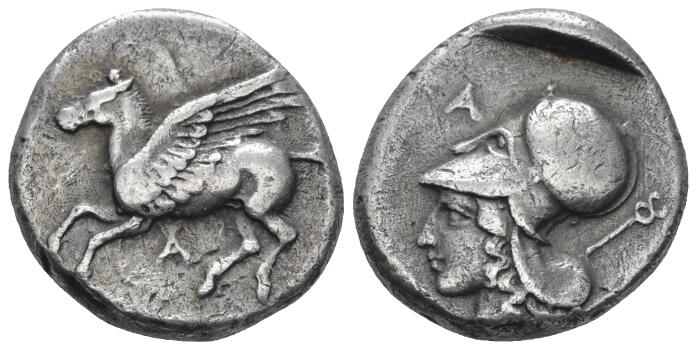355 BCE - 340 BCE | TAPAΣ
Overstriking coin
SO 1298 - Taras over Ambracia.png
Overstruck variety
Ambracia Athena Pegasus right.jpeg
[1]
|
|
Sale(s)Sale(s) ᵖ:
|
Sotheby's, L, 24 Feb. 1904, 113
|
| Private collection(s)Private collection(s) ᵖ:
|
Locker Lampson collection, n° 12; Lisbon, Gulbenkian, n° 28
|
|
Description
| ObverseInscription or printing placed on the obverse.:
|
Male character seated on horse left, nude, wearing helmet, holding reins in one hand, spear and shield in the other. Below horse belly, Δ.
|
ReverseInscription or printing placed on the reverse.:
|
TAPAΣ (Greek) Male character (Taras or Phalanthos), nude, seated on a dolphin to left, holding trident. Below, K and wave pattern.
|
Mint and issuing power
| MintIdentifies the place of manufacture or issue of a numismatic object.:
|
Taras
|
Ancient regionAncient region.
|
Calabria
|
Modern countryModern country: Italy
|
AuthorityIdentifies the issuing power. The authority can be "pretended" when the name or the portrait of X is on the coin but he/she was not the issuing power. It can also be "uncertain" when there is no mention of X on the coin but he/she was the issuing power according to the historical sources:
|
|
Chronology
| FromIdentifies the initial date in a range assigned in a numismatic context. 355 BCE toIdentifies the final date in a range assigned in a numismatic context.. 340 BCE
|
Classical 480-323 BC  periodTime period of the numismatic object. periodTime period of the numismatic object.
|
Physical description
MetalThe physical material (usually metal) from which an object is made.: Silver 
|
WeightWeight of the numismatic object (in grams). in grams: 7.957.95 g <br />7,950 mg <br />
|
DenominationTerm indicating the value of a numismatic object. Examples: tetradrachm, chalkous, denarius.: nomos
|
|
|
|
StandardStandard.: Achaian
|
References
| Coin referenceReference of the Coin:
|
Noe 1957, Group VII, p. 32, pl. XI, h, Fischer-Bossert 1999, Group 47, n° 662b (V253-R513)
|
Coin series referenceReference to coin series study:
|
Noe 19571Noe 1957, Group VII, p. 32, pl. XI, h, Fischer-Bossert 19992Fischer-Bossert 1999, Group 47, n° 662b (V253-R513), HN Italy3HN Italy, n° 877, HGC 14HGC 1, n° 775
|
| Coin series web referenceCoin series web references:
|
|
Description
| ObverseInscription or printing placed on the obverse.:
|
Pegasus flying.
|
ReverseInscription or printing placed on the reverse.:
|
Head of Athena.
|
Mint and issuing power
| MintIdentifies the place of manufacture or issue of a numismatic object. ᵖ:
|
Corinth
|
Ancient regionAncient region. ᵖ
|
Peloponnesus
|
Modern countryModern country: Greece
|
AuthorityIdentifies the authority in whose name (explicitly or implicitly) a numismatic object was issued. ᵖ:
|
|
Chronology
| FromIdentifies the initial date in a range assigned in a numismatic context. 400 BCE toIdentifies the final date in a range assigned in a numismatic context.. 340 BCE
|
Classical 480-323 BC  periodTime period of the numismatic object. periodTime period of the numismatic object.
|
Physical description
| DenominationTerm indicating the value of a numismatic object. Examples: tetradrachm, chalkous, denarius. ᵖ:
|
stater 
|
|
|
References
References
- ^ Noe, Sydney P. (1957), "Overstrikes in Magna Graecia", American Numismatic Society. Museum Notes 7, p. 13-42, pl. 5-14.
- ^ Fischer-Bossert, Wolfgang (1999), Chronologie der Didrachmenprägung von Tarent, 510-280 v. Chr., Berlin, De Gruyter, xvii, 495 p., [84] pl.
- ^ Rutter N. Keith et alii (eds.) (2001), Historia Numorum Italy, London, xvi, 223 p., 43 pl.
- ^ Hoover, Oliver D. (2018), The Handbook of Greek Coinage Series, Volume 1. Handbook of Coins of Italy and Magna Graecia, Sixth to First Centuries BC., Lancaster-London, 2018, lxi, 527 pages, 23 cm
- ^ Calciati, Romolo (1990), Pegasi, Mortara, Edizioni I.P..
- ^ Hoover, Oliver D. (2014), Handbook of Greek Coinage Series 4. Northern and Central Greece : Achaia Phthiotis, Ainis, Magnesia, Malis, Oita, Perrhaibia, Thessaly, Akarnania, Aitolia, Lokris, Phokis, Boiotia, Euboia, Attica, Megaris and Corinthia, sixth to first centuries BC, Lancaster, lxxi, 563 p.


